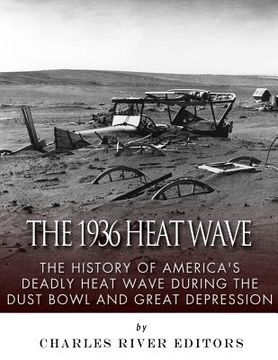The 1936 North American Heat Wave: The History of America's Deadly Heat Wave during the Dust Bowl and Great Depression
Synopsis "The 1936 North American Heat Wave: The History of America's Deadly Heat Wave during the Dust Bowl and Great Depression"
*Includes pictures *Includes newspaper accounts and individual accounts of the heat wave *Includes online resources and a bibliography for further reading "People caught in their own yards grope for the doorstep. Cars come to a standstill, for no light in the world can penetrate that swirling murk.... The nightmare is deepest during the storms. But on the occasional bright day and the usual gray day we cannot shake from it. We live with the dust, eat it, sleep with it, watch it strip us of possessions and the hope of possessions." - Avis D. Carlson While farmers were planting crops, the seeds were also being sown for a natural disaster once a severe drought hit the prairie land in the 1930s. Due to a lack of proper dryland farming methods, wind erosion and the drought combined to create horrific dust storms that devastated wide swathes of Great Plains and even reached cities on the East Coast like New York City and Washington, D.C. It's estimated that the dust storms affected about 100 million acres during the decade, uprooting not just soil but tens of thousands of people as their farms and families suffered. With farms failing across vast portions of Texas, Oklahoma, New Mexico Colorado and Kansas, those who could no longer support themselves became migrants, moving to other states like California, but the country was still in the throes of the Great Depression. As a result, there was a unique class of suffering that was documented not only in pictures but in graphically realistic novels like John Steinbeck's The Grapes of Wrath. Pictures of abandoned farms that looked like post-apocalyptic ghost towns helped drive the crisis home. At the height of the Dust Bowl came a heat wave in 1936, and ironically, the weather early that year did not exactly suggest that heat would be a problem. December 1935 was seasonably cold, and February 1936 was downright frigid. In fact, February was the coldest month in the nation's history, with a number of cities recording record low temperatures. As a result, when the weather began to warm up in March and April, people breathed a sigh of relief, but it kept getting warmer, and rain ceased to fall in some areas. By May, there was a crisis building, even as people maintained hope that each rainstorm would end the heat wave. They were wrong. June saw temperatures rise to unseasonably warm levels across the American West, as even the normally cool Rocky Mountains became uncharacteristically warm. The end of the month saw the heat wave spread south, as normally warm states grew unbearably hot, setting record high temperatures in excess of 110 degrees. Eight record highs that registered in June 1936 still stand today, and July saw no improvement in the temperatures. The heat was bad in the Plains, and at the same time, a sudden heat wave hit the rest of the nation, driving temperatures through the roof along the East Coast. 13 states in the nation recorded temperatures over 110, with some places in Kansas, North Dakota, South Dakota, and Oklahoma passing 120. To make matters worse, many areas failed to cool off in the evenings, driving some residents to sleep outside on their lawns to find relief. August saw hotspots shift slightly south, as Arkansas, Oklahoma and Texas recorded temperatures in excess of 120. By the end of the summer, the heat wave had killed thousands across the nation, and it was still far from over. Humidity remained low, making the heat somewhat more bearable, but it exacerbated the nationwide drought that kept killing crops. The heat and drought became front page news that even President Roosevelt had to address on a regular basis. The 1936 North American Heat Wave: The History of America's Deadly Heat Wave during the Dust Bowl and Great Depression looks at one of the toughest years in American history. Along with pictures of important people, places, and events, you will learn about the heat wave like never before.

